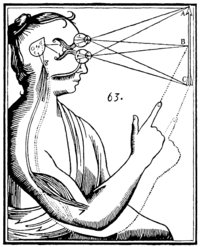
There are two kinds of thought: one kind acts on, affects, moves, changes what it is about, the other kind does not. The kind of thought that makes change is about something invisible, the kind that does not is about something visible.
When we act within ourselves we can't see what we are doing. We make our bodies move, we remember, we imagine.
When we act on the visible world, our power over it comes from knowing its rules. Using our invisible power to move our body, we rearrange the order of visible things in a way our discoveries tell us will make happen again what we want to happen.
Using memory, imagination, and command over our bodies, we have a sense of stability, that we know what we are doing. But whether things outside us will keep to their rules, or change from one moment to the next, we know nothing. We have no power over, we aren't in any continuous relation to these things. We use the power of our thought to move our bodies only to set in motion a machine in which the parts use their own power on each other.
We know what we can and cannot do within ourselves by a lifetime of experience and practice. We don't know what the world can and cannot do, only what it has done so far. What would surprise you more: that the stars in the universe, previously thought to be stable in their movements in relation to each other, suddenly are discovered to be distancing themselves from each other at an ever increasing rate? Or that you suddenly discover you could fly through the air? The first not long ago was confirmed, and no one really cared. But the second....
The rules of the visible world are approximations, which though constantly improving in accuracy and practicality, nonetheless never offer the kind of certainly we have when we move our body or call upon a memory. The invisible kind of things just happen. Their certainty comes from the very fact of there being no intermediary parts with unclear relation to each other. As long as the body is properly functioning the mind's orders will be followed. It is all clear. There is nothing in the sequence of command and execution to fall into decay or malfunction, nothing to be corrected by future reformulation.
We know what we can do with our bodies and thoughts. But our bodies know hardly anything about what they can do with other bodies. They are attracted or repelled, incompletely and irregularly. The things we see in the world blunder around with each other like our bodies do with other bodies.
The more we think about it the more unreal things in the world become. We are powerless to move them with our thoughts. But our thoughts, when they are at their highest perfection, can take us to sight of a world without parts, the way the world looks when we love. In the sight of the world when you are in love the parts are still there. It's just that they have no significance. Which is to say there is nothing we can do with those parts, we have everything we want right now.
The same is true looking at our body from the standpoint of being in love. It is there in sight but has no significance except in thought. It is the tool we've used in the past and will use in the future to return us to love when it's lost.
We start again, looking at the body from the perspective of a state of love we know from experience but are not presently in. We imagine the body in that state, we remember it in that state, we use our invisible power of thought to set the body in movement to take us from the remembered to the imagined by following certain known rules of conduct for returning to love. All this takes place in an invisible world of certainty. Memory is in our power, Imagination is in our power. Rule following is in our power.
It is a mystery what these visible things are, these bodies and things in the world that we are so uncertain about. It could be we don't know anything about them because knowledge is only possible about things we can do something with, exercise our invisible powers on, because that is what we mean by knowledge.
What we know about our body isn't its appearance, only what we do with it, what movement we order it to take. Otherwise we are as powerless to understand it as any other object. We know its movements. That means: the invisible movement of our thoughts cause a movement of a body, which movement, the change of place, from the perspective of any one moment of sight, also is invisible! (When we look at an object we don't see the law that governs its movement.)
Seen in this way our bodies and the rest of the things in the world take on exactly the characteristics of the parts of the world seen when we are in love: distinct and separate, but nothing we can or should do anything directly about. They have their reality in our thoughts, because only there can we do anything with them: they are what we move.
Further Reading:
The Technology Of Magic
Further Reading:
The Technology Of Magic